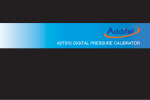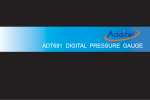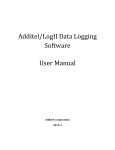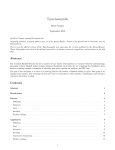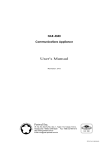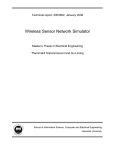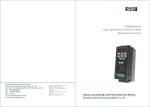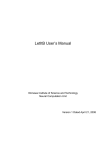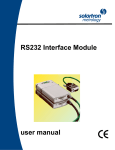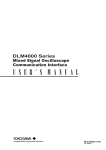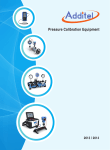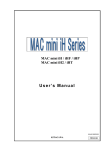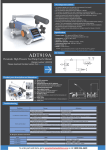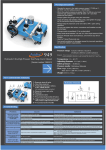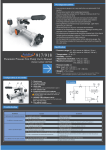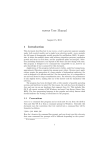Download Instrukcja cyfrowe kalibratory ciśnienia Additel
Transcript
672 DIGITAL PRESSURE CALIBRATOR 672 INTELLIGENT DIGITAL PRESSURE CALIBRATOR User's Manual [Version No.:1105V10] Additel Corporation CONTENTS WELCOME TO YOUR ADT672…………………………………………………………………………………………………………1 FOR YOUR SAFETY…………………………………………………………………………………………………………………………2 SPECIFICATION………………………………………………………………………………………………………………………………3 DESCRIPTION………………………………………………………………………………………………………………………………6 1.0 Summarize…………………………………………………………………………………………………………………………………6 1.1 Basic configuration………………………………………………………………………………………………………………………7 1.2 Terminal introduction……………………………………………………………………………………………………………………8 1.3 Pushbutton Introduction…………………………………………………………………………………………………………………8 1.3.1 Definition……………………………………………………………………………………………………………………………8 1.3.2 Data inputting function……………………………………………………………………………………………………………9 1.4 Screen introduction………………………………………………………………………………………………………………………9 1.5 Main interface definition………………………………………………………………………………………………………………10 1.6 Menu introduction………………………………………………………………………………………………………………………11 1.6.1 Enter into menu……………………………………………………………………………………………………………………11 1.6.2 Operation steps……………………………………………………………………………………………………………………11 1.6.3 Basic function menu………………………………………………………………………………………………………………12 1.6.4 Calibration menu…………………………………………………………………………………………………………………13 1.7 Power supply introduction………………………………………………………………………………………………………………14 BASIC FUNCTION INTRODUCTION……………………………………………………………………………………………………15 2.0 Power on/off………………………………………………………………………………………………………………………………15 2.1 Pressure measure function………………………………………………………………………………………………………………15 Ⅰ 2.1.1 Pressure units………………………………………………………………………………………………………………………15 2.1.2 Pressure zeroing……………………………………………………………………………………………………………………16 2.1.3 Pressure % indication……………………………………………………………………………………………………………17 2.1.4 Peak pressure record………………………………………………………………………………………………………………17 2.1.5 Overpressure warning……………………………………………………………………………………………………………18 2.1.6 Switch over pressure digit…………………………………………………………………………………………………………18 2.2 Electricity measure function……………………………………………………………………………………………………………19 2.2.1 Switch measure items………………………………………………………………………………………………………………19 2.2.2 Electricity measure…………………………………………………………………………………………………………………19 2.2.2.1 Current zeroing………………………………………………………………………………………………………………19 2.2.3 Voltage measure……………………………………………………………………………………………………………………19 2.2.3.1 Voltage zeroing………………………………………………………………………………………………………………19 2.2.4 Temperature measure………………………………………………………………………………………………………………19 2.2.5 Pressure switch measure…………………………………………………………………………………………………………19 2.2.5.1 Operation……………………………………………………………………………………………………………………20 2.2.5.2 Attentions……………………………………………………………………………………………………………………21 2.2.6 Count-down leak hunting…………………………………………………………………………………………………………21 2.2.7 Switch display digits………………………………………………………………………………………………………………22 2.3 DC24V output function…………………………………………………………………………………………………………………22 2.3.1 Power on/off DC24V………………………………………………………………………………………………………………22 2.3.2 DC24V Timing output……………………………………………………………………………………………………………23 2.3.3 Protection for short-circuiting and over current…………………………………………………………………………………23 2.4 Backlight function………………………………………………………………………………………………………………………23 2.5 Buzzer function…………………………………………………………………………………………………………………………23 Ⅱ 2.6 Adjust real time function………………………………………………………………………………………………………………24 2.7 RS232 communication function………………………………………………………………………………………………………25 2.7.1 Set RS232 serial port………………………………………………………………………………………………………………25 2.7.2 Submit data automatically…………………………………………………………………………………………………………25 2.7.3 Communication instructions………………………………………………………………………………………………………25 2.7.4 Software……………………………………………………………………………………………………………………………26 DATA LOGGER FUNCTION………………………………………………………………………………………………………………26 3.0 Basic introduction………………………………………………………………………………………………………………………26 3.1 How to operate save menu………………………………………………………………………………………………………………26 3.1.1 See the saved file……………………………………………………………………………………………………………………27 3.1.2 Delete file's data……………………………………………………………………………………………………………………28 3.1.3 Send file's data via serial port……………………………………………………………………………………………………29 3.1.4 Set file attributes……………………………………………………………………………………………………………………29 3.1.5 Delete all files' data………………………………………………………………………………………………………………29 3.1.6 Send all files via serial port………………………………………………………………………………………………………30 3.1.7 Set save mode………………………………………………………………………………………………………………………30 3.1.8 Enter save-file status………………………………………………………………………………………………………………31 3.1.9 Quit save-file status………………………………………………………………………………………………………………31 3.2 Use manual mode………………………………………………………………………………………………………………………32 3.3 Use hour-record function………………………………………………………………………………………………………………32 3.4 Use interval-record function……………………………………………………………………………………………………………33 3.5 Automatic logging with startup…………………………………………………………………………………………………………34 III HART COMMUNICATION FUNCTION…………………………………………………………………………………………………34 4.0 Connect HART…………………………………………………………………………………………………………………………34 4.1 Set inner/external sampling resistance…………………………………………………………………………………………………35 4.2 HART communication operation………………………………………………………………………………………………………35 4.3 Display status……………………………………………………………………………………………………………………………36 4.4 HART detective linkage…………………………………………………………………………………………………………………36 4.5 HART function introduction……………………………………………………………………………………………………………37 4.5.1 Function 1: Display SENSOR range………………………………………………………………………………………………40 4.5.2 Function 2: Display PV range, switch PV unit, transfer PV range………………………………………………………………41 4.5.3 Function 3: Display and adjust damp time………………………………………………………………………………………42 4.5.4 Function 4: display CP value and PV value………………………………………………………………………………………43 4.5.5 Function 5: display CP value and AO value………………………………………………………………………………………43 4.5.6 Function 6: Display CA and AO value……………………………………………………………………………………………44 4.5.7 Function 7: Loop analog current test, AO calibration……………………………………………………………………………44 4.5.8 Function 8: PV calibration process………………………………………………………………………………………………46 4.5.9 Function 9: Special calibration function…………………………………………………………………………………………48 CALIBRATION FUNCTION………………………………………………………………………………………………………………49 5.0 Introduction………………………………………………………………………………………………………………………………49 5.1 Calibration condition……………………………………………………………………………………………………………………49 5.2 Calibration menu's operation and content……………………………………………………………………………………………49 5.3 Pressure calibration……………………………………………………………………………………………………………………49 5.4 Cancel pressure calibration……………………………………………………………………………………………………………52 5.5 Current calibration………………………………………………………………………………………………………………………52 IV 5.6 Cancel current calibration………………………………………………………………………………………………………………52 5.7 Voltage calibration………………………………………………………………………………………………………………………52 5.8 Cancel voltage calibration………………………………………………………………………………………………………………52 5.9 Cancel previous pressure zeroing………………………………………………………………………………………………………52 6.0 Accessories………………………………………………………………………………………………………………………………53 APPENDIX I: THE TYPICAL APPLICATION OF ADT672…………………………………………………………………………54 (1) Pressure dial gauge calibration…………………………………………………………………………………………………………54 (2) Pressure switch calibration……………………………………………………………………………………………………………55 (3) Pressure transmitter calibration………………………………………………………………………………………………………56 (4) Automatic pressure calibration system…………………………………………………………………………………………………57 APPENDIX II: COMMUNICATION PROTOCOL………………………………………………………………………………………58 (1) Instruction format………………………………………………………………………………………………………………………58 (2) Instruction details………………………………………………………………………………………………………………………59 (3) The file's transfer format………………………………………………………………………………………………………………63 (4) Pressure units shortening list……………………………………………………………………………………………………………63 (5) Pressure units info code …………………………………………………………………………………………………………………63 (6) The format of automatically data transfer……………………………………………………………………………………………63 (7) Wrong sequence number explanation…………………………………………………………………………………………………64 (8) HART function's return format…………………………………………………………………………………………………………64 V Welcome to your ADT672 This detailed user's manual will help you to became familar with the many features of ADT672 Calibrator.The simple step by step instructions will quickly guide you through the procedures for using the calibrator and other items needed for accurately testing and calibrating numerous types of instruments. All products made by Additel are warranted to be free of defects in workmanship and materials for a period of one (1) year from the date of shipment. No other express warranty is given, and no affirmation of Seller, by words or actions, shall constitute a warranty. SELLER DISCLAIMS ANY IMPLIED WARRANTIES OF MERCHANTABILITY OR FITNESS FOR ANY PARTICULAR PURPOSES WHATSOEVER. If any defect in workmanship or material should develop under conditions of normal use and service within the warranty period, repairs will be made at no charge to the original purchaser, upon delivery of the product(s) to the factory, shipping charges prepaid. If inspection by Additel or its authorized representative reveals that the product was damaged by accident, alteration, misuse, abuse, faulty installation or other caused beyond the control of Const Group, this warranty does not apply. ADDITEL MAKES NO WARRANTY OF ANY KIND WITH REGARD TO THIS MANUAL, INCLUDING, BUT NOT LIMITED TO, THE IMPLIED WARRANTIES OF MERCHANTABILITY AND FITNESS FOR A PARTICULAR PURPOSE. Please Notice:The product specifications and other information contained this manual are subject without notice. Additel has made a concerted effort to provide complete and current information for the proper use of the equipment. If there are questions regarding this manual or the proper use of the equipment, contact Additel at: 1 TEL:(714)998-6899 E-MAIL:[email protected] FAX:(714)998-6999 WEB:www.additel.com For your safety Media & Overpressure: (-100kPa~400kPa): Non-corrosive and unpolluted gas; (Higher than 400kPa): media compatible with 316 Stainless Steel. Overpressure: 120%. Burst pressure: 300%. Warning: Follow all equipment safety procedures. Do not operate the calibrator around explosive gas, vapor, or dust. Do not put the battery in the fire or make electricity short circle; Use charger supplied by Additel only. Never apply more than 32V between mA terminal and common terminal. Recharge or replace the battery as soon as the battery indicator appears. Avoid the feculences block the pressure port. Do not allow water inside the case, please clean and maintain the calibrator periodically. Do not apply more than 11V voltage to rechargeable jack.( any problem caused by that is beyond our warranty range). To avoid over pressure damages, do not apply pressure that exceeds the limits listed in the pressure specification table. To avoid mechanically damaging the calibrator, do not apply torque between the pressure fitting and the calibrator case. Do not disassemble the calibrator. Any problem caused by that is beyond our service range. 2 Specification ◆Pressure ranges Gauge Pressure [1] 3 Absolute Pressure P/N Pressure Range (psi) Pressure Range (bar) V15 GP2 GP5 GP10 GP15 GP30 GP50 GP100 GP300 GP500 GP1K GP3K GP5K GP10K GP15K GP25K GP30K GP36K -15 2 5 10 15 30 50 100 300 500 1000 3000 5000 10000 15000 25000 30000 36000 -1.0 0.16 0.35 0.7 1.0 2.0 3.5 7.0 20 35 70 200 350 700 1000 1600 2000 2500 Media [2] G G G G G , L [3] G , L [3] G,L G,L G,L G,L G,L G,L G,L G,L G,L G,L G,L G,L Accuracy (% FS) Burst Pressure 0.025 (0.05) 0.025 (0.05) 0.025 (0.05) 0.025 (0.05) 0.025 (0.05) 0.025 (0.05) 0.025 (0.05) 0.025 (0.05) 0.025 (0.05) 0.025 (0.05) 0.025 (0.05) 0.025 (0.05) 0.025 (0.05) 0.025 (0.05) 0.1 0.1 0.1 0.1 3X 3X 3X 3X 3X 3X 3X 3X 3X 3X 3X 3X 3X 2X 2X 1.5 X 1.5 X 1.5 X P/N AP5 AP10 AP15 AP30 AP50 AP100 AP300 AP500 AP1K AP3K AP5K Pressure Pressure Range Range Media (psi) (bar) 5 10 15 30 50 100 300 500 1000 3000 5000 0.35 0.7 1.0 2.0 3.5 7.0 20 35 70 200 350 G G G G G G,L G,L G,L G,L G,L G,L Accuracy Burst (% FS) Pressure 0.1 (0.2) 0.1 (0.2) 0.1 (0.2) 0.1 (0.2) 0.1 (0.2) 0.1 (0.2) 0.1 (0.2) 0.1 (0.2) 0.1 (0.2) 0.1 (0.2) 0.1 (0.2) 3X 3X 3X 3X 3X 3X 3X 3X 3X 3X 3X Differential Pressure P/N DP1 DP2 DP5 DP10 DP20 Dp30 Pressure Pressure Range Range Media (inH2O) (mbar) 1 2 5 10 20 30 2.5 6.0 10 25 50 100 G G G G G G Accuracy Burst (% FS) Pressure 0.4 0.2 0.1 0.1 0.05 0.05 100 X 100 X 50 X 20 X 20 X 20 X Note: [1]. Sealed gauge pressure for above 1000 psi [2]. G=Gas, L=Liquid [3]. 0.025% FS for gas media only ◆Instrument type: HART type and basic type (non-HART). ◆Pressure units: mmH2O mmHg psi kPa MPa Pa mbar bar (not all units is displayed in all ranges). ◆Overpressure warning: The screen will flash if measuring pressure over 120%FS. ◆Electricity measure and Source Accuracy: Range Accuracy Voltage DC ±30.0000V ± (0.02%RD+0.003%FS) Current DC ±30.0000mA ± (0.02%RD+0.003%FS) DC 24V 24V±0.5V max:50mA Protect at: 120mA Switch [1] Status OPEN/CLOSED Note: [1] 1~12V if switch has detective voltage ◆Working environment: a. Temperature:(-10~50)℃; b. Relative humidity:<95%; c. Atmosphere pressure :( 86~106)kPa. ◆Storage Temperature: -20℃~70℃. ◆RS232 parameter: Baud rate 1200, 2400, 4800, 9600; Data length is 8 bits; stop bits is 2; address is from 1 to 112. ◆Clock Format:【Y/M/D H:M】the range of year is 2000~2099, 24 hours. ◆Save file capacity: 30 files, 40 records per file. 4 ◆Save file mode: Manual mode and automatic mode (includes hour-record and interval-record "from 1 second to 100 hours"). ◆Display: Big segment FSTN LCD with dual lines, grey background and blue backlight. ◆Power supply: Polymer Li-ion rechargeable battery or 10V charger. ◆Charge mode: Special 10V charger (Charge time is 4 hours) . ◆Battery life: 40 hours (The battery icon will flash and buzzer will beep if low power; It will self-power off in case of no power). ◆Re-calibration period: One year. ◆Size: Φ120mmx 46mm, total 184mm high. ◆Weight: 0.7kg. ◆Electric connection: I/V/SWITCH measure: standard Φ4mm jack Recharge: standard Φ4 rechargeable socket DC24V output: standard Φ4mm jack RS232: standard DB9 socket ◆Pressure connectors: 1/4” NPT or 1/4” BSP male Other connections available per request 0.156 inch (Φ4 mm) test hose (for differential pressure) 5 Description 1.0 Summarize The ADT672 is a portable intelligent digital pressure calibrator, it is designed to a rugged calibration tools which has the functions to calibrate and maintain and overhaul the pressure instruments. Features: ① High-accuracy pressure measure &Wide-range temperature compensation. ② Measure function to mA, V and switch. ③ HART communication function. ④ DC24V output. ⑤ RS232 port to connect with computer. ⑥ Data logger. ⑦ Assistant measure function for time and temperature. ⑧ A/C or D/C (rechargeable battery). According to about functions, ADT672 also have some other common functions as below: ① Record the peak pressure; ② Indicate % pressure; ③ Pressure leak hunting; ④ Trigger switch control; ⑤ Timing data recording; ⑥ Operate HART pressure transmitter. As a master gauge(or reference gauge), ADT672 digital pressure calibrator is to measure(or calibrate)pressure instruments likes as pressure transmitters(differential pressure), pressure switches, precision pressure gauges, industry pressure gauges, sphygmomanometers, pressure transducer and others. 6 1.1 Basic configuration 672 672 DIGITAL PRESSURE CALIBRATOR DIGITAL PRESSURE CALIBRATOR ! Units A 0 25 50 75 100 Range:(0~100)kPa Media:Gas Accuracy:±0.02%FS Overload:200kPa Current Measurement Range:-30mA~30mA Voltage Measurement Range:-30V~30V Accuracy:±(0.02% rdg+0.003%FS) Power Output:DC24V@max 50mA Power Supply:Rechargeable polymer lithium battery or special adapter Prod.Date:2009.05 Prod.S/N:0910001 Additel Corporation Figure 1-1: Configuration view 7 1.2 Terminal introduction As basic configuration view 1-1, ADT672 have 5 standardΦ4mm terminals, from left: ◎SW:Positive terminal for switch measure, red color. ◎V:Positive terminal for voltage measure, red color. ◎mA:Positive terminal for current measure, red color. ◎COM:Communal terminal, black color. ◎24V:Positive terminal for D/C output, red color. 1.3 Pushbutton Introduction 1.3.1 Definition Power on/ off. Units Switch pressure units. Pressure to zero (gauge/differential pressure range: -1%FS~1%FS; as for absolute pressure, please refer 2.1.2). Current/voltage to zero (Range: -0.2%FS~0.2FS). 1st function: switch measure type by the sequence of current/voltage/temperature/pressure switch/count-down; 2nd function: enter or exit HART linkage status. 1st function: Press it to enter into basic function menu or password inputting menu; 2nd function: Cancellation (ESC). 8 ← Confirmation ( ). 1st function: backlight; 2nd function: move decimal digit left(←). 1st function: Under the status of file saving, press it once to save a new record or exit; 2nd function: Under the status of non-saving, press it to enter into the save file menu; 3rd function: Move decimal digit right (→). 1st function: Press it shortly to startup/stop calibrator to send out data via serial port; 2nd function: Switch the display digits of pressure measure(5 or 6); 3rd function: Move decimal digit up (↑). 1st function: Turn on/ off DC24V power; 2nd function: Switch the display digits of current/voltage/temperature; 3rd function: move decimal digit down (↓). 1.3.2 Data inputting function (↑), (→) Move decimal digit left and right (↓) Increase/decrease the pressure value Confirm the inputted data ( ← (←), ) Cancel the inputted data (ESC). 1.4 Screen introduction Battery level: Three bars show the battery level, ADT672 will self-turned off if low battery. Date and time: 【Year/Month/Day Hour: Minute】, the range is 2000~2099. Communication: If this icon is appear, 3 roll bars is to indicate the ADT672 is sending out the data via RS232. 9 24V: This icon shows if 24V is turned on or off. Date and Time Communication 24V Pressure Units Pressure reading: display the measuring pressure value. Battery level Pressure units: display the selected pressure units. HART status: The icon shows the communication status, and HART Statas shows HART function. Count-down icon: The cursor starts to circumrotate simultaneously Electricity Units the character Pressure Reading Electicity Reading Count-down Icon when the count-down mode works. Electricity reading: display the measuring electricity value. Electricity units: display the measuring current/voltage units. Light pillar area: indicate % pressure; the % saving files. Left reading area Light pillar area Right reading area Figure 1-4: Screen introduction Left reading area: It shows the actual pressure percentage (0%~199%);In data logging, it indicates file number at present. Right reading area: It shows the actual pressure percentage (0%~199%); In data logging, it indicates all quantity of saved files. 1.5 Main interface definition The interface of ADT672 includes main interface and menu interface. Main interface displays all measuring data, as figure 1-5. After ADT672 is turned on, the menu interface displays two kinds of status. Figure 1-5: Main interface 10 (1) In general, the default of main interface is: Electricity measure mode is current, five digits to display; Pressure measure displays five digits; The pressure unit is the marked unit of front panel in ADT672. Example: As to the calibrator with (0~100) kPa, the default pressure unit is kPa. (2) Under the mode of long time record, the default of main interface is: The electricity measure is same as previous mode, five digits to display; Pressure measure displays five digits; The pressure unit keeps same as the previous; Retain the previous record mode. main interface main interface 1.6 Menu introduction press shortly 1.6.1 Enter into menu Includes the basic function menu and calibration menu, refer figure1-6-1. basic function menu press shortly press longer input password[2003] press shortly 1.6.2 Operation steps calibration function menu press shortly Enter main menu Press 11 Select sub-menu Enter sub-menu to return to the previous menu or exit. Figure 1-6-1: How to enter into the menu 1.6.3 Basic function menu (peak record) higher peak value lower peak value (pressure leak hunting) (select trigger type) (file setting) basic function menu (RS232 set up) (set time) (no trigger) (off → on) (on → off) (off → on → off dual trigger) (on → off → on dual trigger) select file (Not an item in menu,but user must select a file's number firstly to enter into the next menu) (check a file) (delete a file) (send a file) (set a file) (delete all files) (send all files) (hour record) (manual) (save mode setting) (interval record after start up) (automatic) (start file save) (start to save automatically after startup Non-startup, startup) (address set up) (baud rate set up) (adjust time) (set 24V time) (buzzer setting) (HART resistance setting) (10minute) (30minute) (60minute) (keep turning on) (turn off) (turn on) (outer resistance) (inner resistance) 12 1.6.4 Calibration menu input password(2003) (pressure calibration) (pressure calibration effected,cancel calibration) calibration function menu (current calibration) (current calibration effected,cancel calibration) (voltage calibration) (voltage calibration effected,cancel calibration) (zeroing before pressure is canceled) N.B:① ② is not an item of menu. If enter into the menu, please input the correct password. The calibration status. 0: Not calibrate, 1: calibrated. Because this operation is once-off, please be careful to use. The calibration methods of current/voltage are same as pressure calibration. 13 1.7 Power supply introduction ADT672 have two kinds power source: special 10V adapter and rechargeable battery. Battery Model:Model number 9702 Adapter Model: Model number 9814 Figure 1-7-1: recharge Figure 1-7-2: replace a new battery 14 ① Battery model: Model number 9702 Type: Polymer Li-ion rechargeable battery ② Adapter mode: Model number 9814 Input: AC85V~AC245,50Hz/60 Hz ③ The icon Standards: 7.4V/8.4V, 1600mAh indicates the battery lever, please recharge or replace a new battery timely if the icon appears. ④ The rechargeable time is four hours. ⑤ Follow all safety vegulations and use adapter from Additel only. Basic function introduction model No. 2.0 Power on/off lower limit By pressing pressure unit , ADT672 will be powered on/ off. The displayed sequence is model number, pressure ranges higher limit and the main menu. The startup interface as figure 2-1. 2.1 Pressure measure function Figure 2-0: Start up interface 2.1.1 Pressure units By pressing Units , the pressure units can be switched by the sequence of Pa kPa MPa mbar bar psi mmH2O mmHg. Remark: In order to avoid the readings overflow or too low to read, only some of pressure units are selected. The conversion relation as below: Pa 1000 15 kPa 1 MPa 0.001 mbar 10 bar 0.01 psi 0.14504 mmH2O 101.974 mmHg 7.50061 2.1.2 Pressure zeroing Clear the pressure value to zero by pressing . 1.The displayed pressure is 100.02, but the actual pressure is 100.00 (1) As to gauge or differential pressure, please clear it to zero if the measuring pressure is in the range press 2.First digit start to flash of (-1% ~ 1%) FS. Firstly, connect the pressure port with atmosphere. After the data is steady, press to zero. input (2) As to absolute pressure, it is hard to make vacuum. 3.Input the actual atmosphere pressure 100.00 Here introduces another zeroing method: a.Connect the ADT672 with atmosphere, the measuring pressure is Pmeasure. However, the 4.After confirmation,the measured data ia 100.00 actual atmosphere pressure is Pstandard. There is a warp of (Pstandard-Pmeasure), please operate zeroing now. b.The first digital starts to flash by pressing Figure 2-1-2: Absolute pressure to zero . Please input the actual atmosphere pressure value Pstandard. c.Zeroing operation is finished if the pressure is changed from Pmeasure to Pstandard. Attention: User could cancel the previous zeroing by select the 7th option . 16 2.1.3 Pressure % indication The % pressure is indicted by the light pillars, including: ① Left reading area: Range is (0%~199%)FS; minimum resolution is 1%; ② Right reading area: Range is (0%~199%)FS; minimum resolution is 1%; ③ Light pillar area: Range is (0%~100%)FS; minimum segment is 5%. Under the interface of non-saving,three areas are relative to the measuring pressure P. The calculation formula is below: Positive pressure (0~PH): %= | P | / PH; Negative pressure (PL ~0): %=| P | / | PL |; Compound pressure (PL ~ 0~PH): % = | P | / PH; condition [P ≥ 0]; % = | P | / | PL |; condition [P < 0]. Example: ADT672 w/ (0~2)MPa, Light pillar area as figure 2-1-3 if the pressure is 1MPa. Figure 2-1-3 % Light pillar area 2.1.4 Peak pressure record The ADT672 self-records the maximum and minimum pressure. The peak value can be checked or cleared by selecting .The operation steps as following: (1) In the main interface, the pressure value is P. (2) Press 17 to enter into basic function menu, use to select (PEAK), and press . (3) Screen shows the maximum and minimum pressure value. (4) Press to clear the maximum and minimum pressure, and set P as the current pressure. (5) Select the suitable pressure unit by pressing Units (6) Return to basic function menu by pressing . (7) Return to main interface by pressing . , and start to record the maximum pressure and minimum pressure. (8) If there is any higher or lower peak value, the ADT672 will record it automatically and instead of the previous peak value. (9) After a while, user can repeat step (2), (3) to check the peak value, and repeat the step (6), (7) to exit. (10) If user needs to record a new peak value, please repeat the steps (1) ~ (7). 2.1.5 Overpressure warning If overpressure happened, the buzzer won't continuously beep until it is lower than 120% again. Attention: No matter the buzzer is turned on or off, it would keep warning to remind user. The warning conditions: (Assuming the pressure is P) Positive pressure (0~PH): | P | > 1.2 * PH ; Negative pressure (PL ~0): | P | > 1.2 * | PL |; Compound pressure (PL ~ 0 ~ PH): | P | > 1.2 * PH, if [P ≥ 0]; | P | > 1.2 * | PL |, if [P < 0]. 2.1.6 Switch over pressure digit In the main interface, press to switch the pressure reading between 5 digits and 6 digits. 18 2.2 Electricity measure function 2.2.1 Switch measure items By pressing , switch the measure items by the sequence of current(mA), voltage(V), environment temperature(℃), switch , count-down pressure leak hunting . 2.2.2 Electricity measure Electricity terminal is: ◎mA ◎COM 2.2.2.1 Current zeroing If it is in the range of (0~±0.2%FS), please clear the current value to zero by pressing . 2.2.3 Voltage measure Electricity terminal is: ◎V ◎COM 2.2.3.1 Voltage zeroing If it is in the range of (0~±0.2%FS), please clear the voltage value to zero by pressing . 2.2.4 Temperature measure The range is (-20~80)℃ and resolution is 0.1℃. This function is to measure the inner temperature of ADT672, so that it has some warp with actual environment temperature. However, user can take it as a reference. 2.2.5 Pressure switch measure Electricity terminal is ◎SW ◎COM Indication icons: is switching off ; is switching on . There are five triggering modes that is set in basic function menu, as below: 19 (1) Press no trigger to enter into the basic function menu, select (SWITCH) by using and confirm . off → on (2) Screen shows triggering mode menu, please select the suitable mode by using and confirm on → off . off → on → off dual trigger 2.2.5.1 Operation on → off → on dual trigger The factory default is【No triggering】 (1) No triggering: Just monitor switch status but not lock the screen. (2) Triggering off→on: The screen is locked while the triggering is Figure 2-2-5: Triggering mode selection changed from switching off to switching on. Also, the screen shows pressure measure value the momentary pressure value and switch status. By the way, press to restart a new trigger. switch status is "off" (3) Triggering on→off: The screen is locked while the triggering is changed from switching on to switching off. Also, the screen shows switch "on" restart triggering moment, lock the pressure value the momentary pressure value and switch status. By the way, press to restart a new trigger. (4) Triggering off→on→off : It is combined by the mode 2 (off→on) and mode 3 (on→off), it have three steps as following: 1st step: The screen is locked after it is changed from "off" to "on", "off" → "on" hold Figure 2-2-5-1: triggering "off"→"on" process 20 please unlock the screen by pressing ; nd 2 step: The screen is locked after the trigger status changed from "on" to "off", please unlock the screen by pressing pressure measure value ; switch status is "off" rd 3 step: Go back to 1st step to restart the new double triggering. (5) Triggering on→off→on:It is combined by the mode 3 (on →off) and mode 2 (off →on), it have three steps as below: hold screen switch "off" triggering moment, lock the pressure value 1st step: The screen is locked after it is changed from "on" to "off", please unlock the screen by pressing restart switch "on" ; "off" → "on" nd 2 step: The screen is locked after the trigger status changed from "off" to "on", please unlock the screen by pressing ; rd unlocked hold Figure 2-2-5-2 "off" →"on" →"off" dual triggering 3 step: Go back to 1st step to restart anew double triggering. 2.2.5.2 Attentions (1) Switch can take D/C (1~12V). Please distinguish the anode and cathode. (2) At the status of file saving and triggering mode, the ADT672 will save one record automatically at the moment of triggering happened, and no need to pressing . 2.2.6 Count-down leak hunting This function is to measure the chamber's sealed performance, as below: (1) Connect the ADT672 with chamber together, supply a certain pressure P1. (2) Please record the second pressure P2 when the set time T is arrived. 21 (3) According to the margin of P1 - P2, user can confirm if the sealed performance is good. Please refer the figure 2-2-6-1 for pressure leak hunting process.The longest starting pressure P1 count-down time format [hour:minute:second] icon stop time is 99 hours 59 minutes and 59 seconds. The default is 10 seconds. It can be set in the basic function menu, as below: (1) Please select the (LEAK) and (SET). (2) As figure 2-2-6-2, please input the time as format【hour: minute: second】, confirm it and return the main interface by pressing process pressure P count-down time format [hour:minute:second] icon round . count-down to 00:00:00 finish pressure P2 2.2.7 Switch display digits In the main interface, pressure value is switched between 5 digits and 6 digits by pressing start to count-down starting pressure P1 icon stop . restart 2.3 DC24V output function Electricity terminal is ◎24V ◎COM. Figure 2-2-6-1: Count-down leak hunting Hour 2.3.1 Power on/off DC24V Minute Second In the main interface, please turn on the DC24V output by pressing (icon appear). Press again to close the DC24V (icon disappears). It is suggested to turn off the DC24V function if it is not used. first digit flashed to adjust Figure 2-2-6-2: Count-down time setting 22 2.3.2 DC24V timing output This function is to protect the unnecessary power consumption if user forgets to close DV24V. The operation steps as following: (1) Please select (output 24V) in the basic function menu. (2) As figure 2-3-2 Screen, screen shows the time option of DC24V output. 10minute 30minute Please select the best time. (3) When the selected time is up, DC24V output is closed automatically. Remark: under the condition of HART communication, DC24V output function is forbidden to use. 60minute keep turning on Figure 2-3-2 DC24V time setup 2.3.3 Protection for short-circuiting and over current ADT672 will turn off and beep automatically if there is any short-circuit or over current(>150mA) between ◎24V and◎COM. When the alert is released, DC24V will go back to normal status immediately. 2.4 Backlight function In the main interface, press to control the backlight. 2.5 Buzzer function turn off User can set up buzzer status as below: (1) Select the (BEEP) in the main function menu. (2) Select the relative option of turning on or turning off. Buzzer as figure 2-5. 23 turn on Figure 2-5 Buzzer option Remark: The factory default setting is turning on. Buzzer will beeps under the following conditions : (1) Correct keystroke beeps once, and the incorrect beeps twice. (2) Over measure warning (ever buzzer is turned off). (3) The correct communication instruction beeps once. (4) The plugging adapter beeps once. (5) For short-circle or over current, it continuously beeps. (6) The sound is once if the ConST273 is turned on or off. (7) Under the automatic save mode, it beeps once while each record is saved. (8) For switch status changing, it beeps once. (9) If the count-down time is up, it beeps once. 2.6 Adjust real time function The display format is【Year/Month/Day Hour: Minute】, year' s range is 2000~2099, time is 24 hour format. (1) Select (RTC) in the basic function menu. (2) Input the date and time, see figure 2-6. Remark: Do not input the wrong or irregular date or time. cursor beginning position Figure 2-6: Adjust o'clock 24 2.7 RS232 communication function 2.7.1 Set RS232 serial port (ADDRESS) RS232 communication parameter is below: (BAUD RATE) ① Address range is (1~112), factory default is 1; Figure 2-7-1-1: Serial port setup ② Baud rate is (1200, 2400, 4800, 9600), factory default is 9600; ③ The data length default is 8; 2 stop bits; no calibration bit; no data flow control. ④ Hardware port: Standard DB9 socket (2 feet is TXD, 3 feet is RXD, 5 feet is GND) cursor begining position The setup method for address and baud rate is below: a. Select the option (RS232) in the basic function menu. Figure 2-7-1-2: adjust address b. As figure 2-7-1-1, screen displays the setup menu. User can select the communication address or baud rate. c. As figure 2-7-1-2, it shows the current address and indicates to correction if the communication address is selected. d. The cursor position is displayed in the current option of baud rate if the baud rate is selected. 2.7.2 Submit data automatically By pressing , the communication icon appears and the ADT672 is sending the measuring data via RS232 port, meanwhile, 3 bars rolls in turn; by pressing again, the icon disappears and the sending is stopped. Please refer the data sending format in appendix【communication protocols】. 2.7.3 Communication instructions Please refer the APPENDIX II【communication protocols】for more information. 25 Figure 2-7-1-3: Baud rate option 2.7.4 Software Please refer to the CST2000S introduction for more information. Data logger function 3.0 Basic introduction Memory capacity: 30 files, 40 records per file. Manual mode: Select a file from files (1~30), a record is saved by press once till the file is full. Record mode: including hour record, interval record. ◆Hour-record: save one record per every hour. ◆Interval-record: the interval can be set up (1 second ~100 hours). ◆Under the mode of record, the files are saved in turns according to the sequence of file and record. ◆It can be set to the first menu after startup, continue the previous saving. ◆Under the record mode, keypad is locked. By pressing to quit save status and unlock the keypad. Save status: left reading area display the current file number;Right reading area displays the saved records;Light pillar area indicate the % of currend saved files. 3.1 How to operate save menu file No. (1) Enter into save menu. Method 1: Select the Method 2: Press (FILE) in the basic function menu; capacity% indication saved records Figure 3-0 Saving area button in the main interface. 26 (2) Select File No. (File operation in menu) As figure 3-1, select the suitable File No. by using (Range: 1~30), then please press to confirm. (3) File menu options Select the suitable option by using , and confirm . (4) File menu's content Including 8 items, as following: (SEE) see the saved file; (DELETE) delete the a file; (SEND) send out the a file; menu menu option total 8 items. (SET) set file attributes (second gauge #, min scale); (ALL_DELETE) delete all files; (ALL_SEND) Send all a file; (SAVE) Set file's save mode; (SELECT) Select to enter into save mode. the selected file %file capacity Figure 3-1: Select operation files 3.1.1 See the saved file Operation methods: a. Select . b. Screen shows the 1st file's attributes: CODE (second gauge serial No.), factory default is 111111. 27 saved records c. By pressing to show the 2nd item: SCALE (minimum scale), default is 00.1000. d. By pressing it will directly return to the file menu option, if file is vacant. Otherwise, press When the last record is checked, it will return to the file menu option by pressing once to add a file No. . If user want to quit, please press . (Refer the figure 3-1-1-3) menu menu save time saved content file number %file capacity saved records file number Figure 3-1-1-1: second gauge's Serial No. %file capacity saved records Figure 3-1-1-2: minimum scale file number %file capacity saved No. Figure 3-1-1-3: display file's data Remark: The saved pressure value and electricity value is 6 digits. 3.1.2 Delete file's data file No. capacity indication saved records The operation steps: a. Select . b. The deletion process is dynamically displayed in the light pillar area, right and left reading area. (As figure 3-1-2) c. After deletion, screen goes back to file menu option automatically. Figure 3-1-2 File deletion process Remark: This function just delete the file's content, but not file attributes (second gauge's serial No. and minimum scale). 28 3.1.3 Send file's data via serial port Operation steps: a. After connected the ADT672 and computer via RS232 cable, please startup the serial port receiving software and setup the correct baud rate. b. Select . middle c. The sending process is dynamically displayed in the two sides of reading area and light pillar area. (As figure 3-1-3) d. After sending, screen goes back to the file menu. Remark: The sending data format, please refer the appendix II: communication protocol. 3.1.4 Set file attributes Figure 3-1-3 File upload process File attributes includes: The CODE of second gauge, min scale division value. The factory default setting: Second gauge CODE is 111111(6 digits), minimum scale division value: 00.1000 (6 digits). The setup steps: a. Select in the file menu and press . b. Firstly, screen displays the "CODE "of the second gauge, please input the code and press . c. Screen displays the minimum division value (scale), please input the actual division value and press . d. The screen returns to the file menu automatically. 3.1.5 Delete all files' data This function is to delete all data and file attributes, and returns to factory default setting. The operation steps: 29 a. Select . b. The deletion process is dynamically displayed in the two sides of reading area and light pillar area. c. After all files are deleted, the screen returns to the file menu. Remark: This function can be set tare of cursor. Next operation still starts from 0 position of file number 1. 3.1.6 Send all files via serial port The operation steps: a. Connect ADT672 and computer via RS232 cable, start up the receiving software and set up the correct baud rate. b. Select . c. The sending process is dynamically displayed in the two sides of reading area and light pillar area. d. After all files are sent, it returns to the file menu automatically. Remark: Please refer sending data format in the appendix II: communication protocol. hand 3.1.7 Set save mode automatic The operation steps: a. Please select Figure 3-1-7-1: Select save mode . hour b. The screen displays the menu of 2 modes, as figure 3-1-7-1. c. If select manual mode (HAND), screen returns to the file menu. Under the manual mode, one record will be saved by pressing d. If select automatic mode (AUTO), screen returns to the setup menu with logging mode, as figure 3-1-7-2. interval once. mode Figure 3-1-7-2: Setup menu of save mode 30 Automatic mode including hour record and interval record, and the cursor points to the current mode. As figure 3-1-7-2, the 3rd item could decide if the automatic mode is operated automatically after start-up. 【0】: After start-up, not operate automatically; 【1】: After start-up, operate automatically. e. If select (HOUR), it returns to the file menu. Then, a record is saved every hour. f. If select the (INTERVAL), the screen enters into the interval interface. (The interval range: 1 second ~ 99 hours 99 minutes and 99 seconds). After setup, it returns to the record mode. Then, a record is saved in every interval. g. If select (RUN_0), screen displays logging, item (RUN_1). Hereinto, item is long-term logging. Remark: If long-term record mode is set, the electricity type and pressure unit keep same as the previous. 3.1.8 Enter save-file status The operation steps: a. Select and press . Under the manual mode: cursor points to saved file's serial number; Under the automatic mode: cursor points to the previous file's serial number. b. Please return to the main interface by pressing 3.1.9 Quit save-file status Press 31 longer to quit. , then ADT672 enter into the save-file status. is short-term 3.2 Use manual mode (1) In the main interface, enter into the file menu by pressing (2) Select the file's serial number(1~30) by using (3) Select . , press to confirm. (SET) to set file's attributes (optional). (4) Select to set file's save mode and go to the next menu. (5) Select (hand) manual mode, screen returns to file menu. (6) Select to startup the save function. If file is vacant, the cursor will point to the first record. Otherwise, the cursor points to the last record and continue the previous work. (7) Press once to save a record in the main interface. Meanwhile, the record in the right reading area will add 1 (1~40). 3.3 Use hour-record function (1) Press to enter into the file menu in the main interface. (2) Select a file's serial number by using and press . Under the record mode, the starting position always points to the previous. Example: The No.20 record of 10th file of last time is No.1 file of this time. After enter into the automatic mode, the next new position is 21st record of No.10 file. (3) If user initialize save position, select (4) Select (5) Select to delete all file's data, the new position is No.1 record of No.1 file. to set the file's attributes (optional). to set the file's save mode and go to the next menu. 32 (6) Select (7) Select hour record mode, screen returns to the file menu option. to startup the save function, the cursor points to the previous save position. (8) In the main interface, it saves a record each hour till all 40 records is saved. Then, it will automatically switch to the next file till all file's room is occupied. After that, it will automatically switch to the file No.1 and continue the saving. 3.4 Use interval-record function. (1) Enter into the file menu by pressing (2) Select a file's serial number by using in the main interface. and press . Under the record mode, the starting position always points to the previous. Example: The No.20 record of 10th file of last time is No.1 file of this time. After enter into the record mode, the next new position is 21st record of No.10 file. (3) Select (4) Select (5) Select (6) Select to delete all file's data and initialize the save position, the new position is 1st record of 1st file. to set the file's attributes (optional). to set the save mode and enter into the next menu. (interval record mode) to enter into the interval setup interface. (7) Time format is Hour: Minute: Second (Maximum: 99 hours and 59 minutes and 59 seconds; Minimum: 1 second). After time is set, please goes back to automatic mode by pressing (8) Select and goes back to the file menu option by pressing . to startup the save mode. In the main interface, the save file's position keeps same as the previous. (9) In the main interface, it saves a record each hour till all 40 records are saved. Then, it will automatically switch to the next file till all file's room is occupied. After that, it will switch to the file No.1 once again and continue the new saving. 33 3.5 Automatic logging with startup Set the 3rd item in the record mode menu as , it goes to the automatic mode after equipment is restarted. The record status has following features: (1) Electricity type keeps same as the previous (5 digits to display). (2) Pressure measure display 5 digits. (3) Pressure unit keeps same as the previous. How to quit this function: (1) Set record mode 3rd item as . (2) Or, change save mode as manual mode. HART communication function 4.0 Connect HART Before using HART function, user should know the following: (1) The transmitter is HART and current type. (2) The transmitter is supplied by external power or 24V of the ADT672. (3) The 250Ω sampling resistance is supplied by the outer or ADT672 (The default is supplied by the ADT672). 34 HART type transmitter has three kinds of connection types, as figure 4-0. It is recommended to use the first type. 1、inner 24V、inner R 2、outer 24V、outer R + + transmitter-- 3、outer 24V、inner R + transmitter-- - - external power R + + transmitter-- external power ADT672 24V mA COM COM 24V mA ADT672 COM 24V mA ADT672 * 24V is HART+,mA is HARTFigure 4-0: HART communication wiring diagram 4.1 Set inner/external sampling resistance (1) Select (R_IN) in basic function menu. (2) As figure 4-1, screen displays the selection menu.(the default is inner resistance) (3) Press to select the suitable resistance and return to the basic function menu. 4.2 HART communication operation The basic operation steps are: (1) Select the suitable wiring connection and connect the HART type transmitter. (2) Press 35 to enter into the HART status and detect the transmitter. outer resistance inner resistance Figure 4-1: select sampling resistance (3) After the POLLING linked successfully, please to switch nine HART functions. (4) Finally, exit HART communication function by pressing . 4.3 Display status Icon means the current status is HART communication; Characters show the current HART's action or implementation. 4.4 Detective linkage After select the suitable wiring connection, user must enter into the HART function via the POLLING address linkage. CP As well as, user should know the below: (1) All HART transmitters must follow the POLLING detective instructions. CA (2) In general, the POLLING address default is "0" (or 1~15). (3) None but POLLING address linked, the next HART operation can be processed. By pressing Figure 4-4: Linkage interface to link the transmitter, there are following status in HART area: (1) ,linking the"0" address. (2) ,linked the HART, user can process next step. (3) ,failed to link; however, user can press to detect the POLLING address from "1" to "15" again. Supposed address "8" is linked, the screen shows the ; If all address are failed, it returns to After the POLLING linked, user can select the nine HART functions by pressing . . 36 4.5 HART function introduction Before using those functions, user should know the following: (1) Please refer the figure 4-5 for HART transmitter's working sketup map. DIGITAL PRESSURE CALIBRATOR Units calibratior pressure input PV calibration PV zeroing A AO account AO calibration input HART pressure transmitter Figure 4-5: HART transmitter's working sketup map 37 4 - 20mA current loop (2) The shortening words of the ADT672: PV (Primary variable): The pressure measured by HART transmitter CP (Calibrator pressure): The pressure measured by calibrator ADT672. AO (Analog output): The analog output current value set by HART transmitter. CA (Calibrator amp): The current value measured by calibrator ADT672. Sensor range: It is the rated pressure for the sensor in transmitter (If pressure is beyond it, the sensor may be damaged). PV range: The rated range in HART transmitter (Lower limit is corresponding to 4mA, higher limit is corresponding to 20mA). Actual range: The actual range used in HART transmitter (Lower limit is corresponding to 4mA, higher limit is to 20mA). (3) HART function's serial number is displaying in the status area, as is function 1. (4) As figure 4-5, HART pressure transmitter includes: PV calibration and AO calibration. PV calibration: The calibration is between PV and AO. In general, supply the pressure to transmitter, the max/min pressure is same as the higher/lower limit of transmitter. Then, the actual pressure have linearity relationship with the current range (4~20mA) of AO. In fact, PV calibration has same function as the pushbutton【SPAN】&【ZERO】 in the transmitter. AO calibration: The calibration is between AO and CA (4~20mA). In general, transmitter outputs 4mA & 20mA, the CA value measured by calibrator is separately send to the zero register and plus register. Then, AO output value is approximating same as the CA measure value. Example: The actual range of HART transmitter is 0~16kPa, current output is 4~20mA, 0.1%fs accuracy. 38 The every parameter changing like as following list: Before Supplied pressure PV value PV range 00.000 kPa 00.010 kPa 00.000 kPa 16.000 kPa 16.020 kPa 16.000 kPa Calibration calibration AO output CA value Maximum error 4.001 mA 4.024 mA 0.15% 20.020 mA 20.061 mA 0.38% process Supplied pressure PV value PV range AO output CA value Maximum error 00.000 kPa 00.010 kPa 00.010 kPa 4.024 mA 4.024 mA 0.15% 16.000 kPa 16.020 kPa 16.020 kPa 20.061 mA 20.061 mA 0.38% Process 1: PV calibration After Process 2: AO calibration calibration Supplied pressure PV value PV range AO output CA value Maximum error 00.000 kPa 00.010 kPa 00.010 kPa 4.000 mA 4.001 mA 0.006% 16.000 kPa 16.020 kPa 16.020 kPa 20.000mA 20.002mA 0.012% From above lists, the transmitter is unqualified before calibration. However, it meets the accuracy requirements after calibration. Remark:PV calibration and AO calibration is operated by the general instructions of HART protocols. However, AO instruction doesn't support some transmitters. For this situation, ADT672 have a special calibration method to meet the calibration requirements. 39 (5) The ADT672 defined nine HART functions, as below: F1: dISP_SEnSOr ( DISPLAY_SENSOR ) Display pressure range of the sensor in transmitter. F2: dISP_rAngE ( DISPLAY_RANGE ) Display transmitter's PV range, switch PV units, transfer PV range. F3: dISP_dAP ( DISPLAY_DAMP ) Display the transmitter's damp time, and adjust it. F4: dISP_CP-PV ( DISPLAY_CP-PV ) Display the calibrator's CP value and transmitter's PV value. F5: dISP_CP-AO ( DISPLAY_CP-AO ) Display the calibrator's CP value and transmitter's AO value F6: dISP_CA-AO ( DISPLAY_CA-AO ) Display calibrator's CA value and transmitter's AO value. F7: LOOP_AO ( LOOP AO TEST ) Fixed analogue loop current output, AO calibration process(CALIB_AO). F8: CALIB_PV ( CALIBRATE PV ) PV calibration process. F9: CALIB_SPEC ( CALIBRATE SPECIAL ) A special calibration of ConST273, please refer 4.5.9. 4.5.1 Function 1: Display sensor range Sensor range: It is the rated pressure of the sensor in transmitter . If pressure is beyond this range, the sensor may be damaged. The operation methods as following: a. Switch to HART function 1 by pressing b. Display the sensor's range by pressing c. Press , as figure 4-5-1-1. , as figure 4-5-1-2. to return to figure 4-5-1-1; switch to function 2 by pressing . Figure 4-5-1-1: F1 entrance interface 40 4.5.2 Function 2: Display PV range, switch PV unit, transfer PV range lower limit PV range: the rated pressure range in transmitter, lower/higher limit is unit corresponding to the 0mA and 20mA respectively. Switch PV unit: mmH2O mmHg psi kPa MPa Pa mbar bar. higher limit Transfer PV range: Change PV range, and new PV range is corresponding to the AO output. Figure 4-5-1-2: Sensor range The operation methods as following: a. Switch to HART function 2 by pressing b. As figure 4-5-2-2, press to show the PV range and it returns to the inter- face as figure 4-5-2-1 by pressing c. Press Units , as figure 4-5-2-1. .Switch to function 3 by pressing . to switch the PV units. d. The steps of transfer range's lower limit: ① Pressing once, the digit of lower limit will flash once. ② Input the lower limit value, press to confirm. Figure 4-5-2-1: F2 entrance lower limit unit ③ After the screen shows "_ _ _ _ _ _" for 2 seconds, setup is finished. e. The steps of transfer range's higher limit: ① Pressing once, the digit of higher limit will flash once. ② Input the higher limit value, press to confirm. ③ After the screen shows "_ _ _ _ _ _" for 2 seconds, setup is finished. 41 higher limit Figure 4-5-2-1: F2 entrance 4.5.3 Function 3: Display and adjust damp time Damp time:It is the time from starting measure to steady status. The adjustment will enhance anti-vibration performance. (Damp time unit: second). The operation methods as following: a. As figure 4-5-3-1, switch to HART function 3 by pressing b. As figure 4-5-3-2, press . to show the transmitter's damp. Under this interface, press Switch to function 4 by pressing to return to the figure 4-5-3-1. . c. Press the direction keys to adjust the damp value. If adjustment is succeed, the screen displays" _ _ _ _ _ _" for 2 seconds. Otherwise, it will return to the interface as figure 4-5-3-1. damp second Figure 4-5-3-1: F3 entrance interface Figure 4-5-3-2: display damp time 42 4.5.4 Function 4: display CP value and PV value The operation methods as following: a. As figure 4-5-4-1, press b. As figure 4-5-4-2, press to enter into HART function 4. to display CP and PV value; The digits keep same as pressure digits; Under this interface, press to go to figure 4-5-4-1; Press Figure 4-5-4-1: F4 entrance to go function 5. c. Press Units d. Press to switch CP & PV units. (mmH2O mmHg psi kPa MPa Pa mbar bar) unit CP to clear the CP value and PV value to zero. 4.5.5 Function 5: display CP value and AO value PV The operation method as following: a. Switch to HART function 5 by pressing , as figure 4-5-5-1. b. As figure 4-5-5-2, screen shows CP and AO value by pressing Figure 4-5-4-2: display CP value & PV ; the digits of CP and AO are determined by pressure and current respectively. Under this interface, press Press c. Press to switch to the interface as figure 4-5-5-1; to function 6. Units to switch CP unit; Press to clear the CP value to zero. Figure 4-5-5-1: F5 entrance 43 4.5.6 Function 6: Display CA and AO value Operation method: a. As figure 4-5-6-1, press b. As figure 4-5-6-2, press press to HART function 6. to display CA value and AO value; the digits keep same as current digits. Under this interface, to the interface sa figure 4-5-6-1; Press to function 7. unit CP CA AO AO Figure 4-5-5-2: display CP & AO Figure 4-5-6-1: F6 entrance Figure 4-5-6-2: Display CA & AO 4.5.7 Function 7: Fixed loop analog current test, AO calibration This test is to appoint to the fixed loop current analog output of AO value, ADT672 can make transmitter supply the loop analog current of 4mA, 12mA and 20mA. Also, operator can use this test to determine the accuracy of transmitter's output current. If accuracy is unqualified, please start AO calibration as following: 44 (1) Switch to HART Function 7 by pressing (2) As figure 4-5-7-2, press , as figure 4-5-7-1. to display the analog loop current. Switch the points among 4mA, 12mA, 20mA by using Under this interface, press press . to the interface as figure 4-5-7-1, to function 8. Figure 4-5-7-1: F7 Entrance 1st point 2nd point CA 3rd point CA CA Picture 4-5-7-2: Fixed loop current output (3) If the result is not good, please recalibrate AO of transmitter as below: a. Under the interface of figure 4-5-7-2, enter into AO calibration by pressing b. By using (As picture 4-5-7-3). to select the sequence of 4mA calibration or 20mA calibration. After CA value is steady, press to finish the calibration. Once every point is calibrated, the first line shows the character [END] (as figure 4-5-7-4). 45 c. After calibration, press to go to the figure 4-5-7-1. END 1st point 1st point CA CA 2nd point 2nd point CA CA Figure 4-5-7-3: AO calibration entrance END Figure 4-5-8-1: F8 entrance Figure 4-5-7-4: AO calibration process 4.5.8 Function 8: PV calibration process The operation methods: a. Switch to HART Function 8 by pressing b. Press , as figure 4-5-8-1. to enter into the calibration menu. Calibration includes lower limit point and higher limit point. Use 46 to prioritize the calibration points.Then supply the pressure to the selected point. After CA value is steady, press to finished the calibration. Once every point is calibrated, the first line shows the character [END], the second line displays the new lower/higher limit of PV range. (As figure 4-5-8-2) c. After calibration, press to the interface as figure 4-5-8-1, press to function 9. END 1st point 1st point CP PV_LL CA END 2nd point CP 2nd point PV_UL Figure 4-5-8-2: PV calibration process 47 4.5.9 Function 9: Special calibration function For some transmitters, AO calibration instructions cannot be supported. For this situation, ADT672 has a special calibration method to resolve it. After calibration, the actual pressure range has the linearity relationship with current loop CA (4~20mA). This is very useful in application of transmitter with (4~20)mA loop current. Operation steps as below: a. As figure 4-5-9-1, press b. As figure 4-5-9-2, press to entry HART function 9; press to entry the detective linkage again (figure 4-4). to entry calibration menu. ADT672 self-select the higher limit point or lower limit point according to the different pressure supplied by users. After the CP and CA is steady, press to make screen shows "_ _ _ _ _ _" in second line. It shows the current calibration is finished. If this result is not ideal, it could be re-calibrated. CP CA Figure 4-5-9-1: F9 entrance Figure 4-5-9-2: Special calibration interface 48 Calibration function 5.0 Introduction This function is to correct the accuracy of ADT672 periodically,If there is any uncertainty for accuracy, please calibrate it by the professional.This is because random operation could be disturb the inner parameters and even damage the equipment. Firstly, please warm it for 30 minutes around. The battery is preferable calibration power, please try to supply the pressure to full scale thrice and release it. Now, please start the calibration process. If the ADT672 is in irregular working status, please use default setting function. Remark: The calibration must be met the required conditions. 5.1 Calibration condition (1) Environment: Temperature: 20℃±2℃; Relative humidity: (45-75) %; Atmosphere pressure: (86-106) kPa; Power: recommend battery. (2) Equipments: Standard voltage source, standard current source, standard pressure source. 5.2 Calibration menu's operation and content Please refer the [1.6 menu introduction]. 5.3 Pressure calibration Firstly, users should read the followings: (1) As to ADT672 with different pressure range, the calibration point is not same. 49 a. Single pressure range: Two calibration points.Example: the calibration default point for (0~2)MPa,is 0MPa and 2MPa; the default points for (-100~0)kPa is -100kPa and 0kPa. By the way, the calibration point for -100kPa is unable to reach actually. So that, user can revise the calibration point in advanve and then calibrate the revised pressure (like as -80kPa). b. Dual pressure range: Three calibration points.Example: (-20~20)MPa, the default pressure is -20 kPa,0kPa and 20kPa. (2) The calibration points compositor as below: a. 2 points calibration: 1st point is lower limit, 2nd point is higher limit. Example: (0~100)kPa: 1st point: 0kPa, 2nd point: 100kPa; (-100~0)kPa: 1st point: -100kPa, 2nd point: 0kPa. b. 3 points calibration: 1st point is lower limit, 2nd is 0, 3rd point is higher limit. Example: (-20~20)kPa: 1st point: -20kPa, 2nd point: 0kPa, 3rd point: 20kPa. (3) During calibration, user can choose the prioritized points. However, it is suggested to use default setting. Example: ADT672 w/ (0~2) Mpa (1) Press and press (2) Select to enter into passport menu, input the password "2003" to enter into calibration menu. and press standard pressure to enter into the entrance interface.The【01】of left reading area is 1st calibration point, user can select point by using calibration. (as figure 5-3-1) .Please press to start calibration point flash Figure 5-3-1: 1st point entrance 50 (3) The first line flashes to remind user to input the standard pressure of 1st point. (In this example, it is 0.00000MPa) (4) As figure 5-3-2, screen displays the interface of 1st calibration point. Please supply 0.00000MPa pressure, and press to finish the 1st point calibration after it is steady. As figure 5-3-3, screen switch to 2nd point calibration interface. (5) Under the interface of 2nd calibration point, the first line flashes for new standard pressure. In general, it is the default (In this example, it is 2.00000MPa), press for next step. nd (6) As figure 5-3-4, screen displays the 2 point calibration interface. Please supply 2.00000MPa pressure and press to finish the 2nd point calibration after it is steady. The screen switches to the interface as figure 5-3-1, the calibration is finished. (7) Press to return to the calibration function menu. The calibration is effective if standard pressure . standard pressure standard pressure measuring pressure calibration point Figure 5-3-2: 1st point calibration 51 changed to calibration point Figure 5-3-3: 2nd point entrance measuring pressure calibration point Figure 5-3-4: 2nd calibration 5.4 Cancel pressure calibration (1) Enter into the calibration function menu (2) Select and press , the calibration is canceled if screen displays . 5.5 Current calibration It is same as the pressure calibration. The default 3-points calibration points are: ① First points: -30mA; ② Second point: 0 mA; ③ Third point: 30mA. By the way, the standard calibration point can be adjusted. The current calibration menu is . 5.6 Cancel current calibration (1) Enter into the calibration function menu (2) Select and press , the calibration is canceled if screen displays . 5.7 Voltage calibration It is same as the pressure calibration. The default 3-points calibration points are: ① First points: -30V; ② Second point: 0 V; ③ Third point: 30V. By the way, the standard calibration point can be adjusted. The voltage calibration menu is . 5.8 Cancel voltage calibration (1) Enter into the calibration function menu; (2) Select and press , the calibration is canceled if screen displays . 5.9 Cancel previous pressure zeroing (1) Enter into the calibration function menu; (2) Select and press . 52 6.0 Accessories (1) Test cable: Model number 9021 1 set (2) Warranty 1 pc (3) User's Manual 1 pc (4) Adapter: Model number 9814 1 pc (5) Li-ion Battery: Model number 9702 1 pc ~ 53 Appendix I: Typical application of ADT672 (1) Pressure gauge calibration The operation steps are: ① Connect the pressure gauge and ADT672 on the pressure pump. ② According to verification regulation, make ADT672 as a reference gauge to verify (calibrate) the pressure gauge. 54 (2) Pressure switch calibration Operation steps are: ① Connect the pressure switch and ADT672. ② Press to select pressure switch measure. (coptional:please select the triggering type in the menu for pressure triggering measure) ③ According to sketup map, please connect the test in terminals cables. ◎SW connect "+" of switch, red color; ◎COM connect "-" of switch, black color. ④ Follow all verification regulations, take ADT672 as a reference gauge to calibrate (verify) the pressure switch. 55 (3) Pressure transmitter calibration Operation steps as following: ① Connect the pressure transmitter and ADT672 on the pressure test pump. ② Pressing to select the current measure item, and press to start 24V output. If user needs to control the output time,please find the related option in the menu. ③ As right figure, connect the pressure transmitter and ADT672. ◎24V connect the transmitter +, red color. ◎mA connect the transmitter. ④ Following all verification regulations, take ADT672 as a reference gauge to calibrate (verify) the pressure transmitter. Remark: If user wants to calibrate the HART type pressure transmitter, please enter into the HART status by pressing . Please refer the [HART communication function introduction] for further information. 56 (4) Automatic pressure calibration system kPa 表区 mA 设定 电测 压力 000. 00 标准 压力 1.00020 0.000 kPa 动控制 运 行 状 态:手 保持 控 制 状 态: This system can automatically calibrate the pressure indicator, pressure transmitter, pressure switch and other pressure instruments. The ADT672 is a reference gauge (master gauge) in this system. In general, this automatic pressure calibration system has 2 kinds of collocation: ① To calibrate pressure gauge:【ADT672 + Intelligent pressure generator + camera + Computer + software】 ② To calibrate pressure transmitter:【ADT672 + Intelligent pressure controller + computer + software】 57 Appendix II: Communication protocol (1) Instruction format ① Data sending format: A: X: Knnnn: C0: C1: C2: C3: C4+EOS (end of symbol) A: 1 byte, the instrument's communication address X: 1 byte, only for W (write) or R (read) K: 1 byte, M (measure), F (File), O (others) nnnn: 2-5 bytes, the items operated by K instruction C0: C1: C2: C3: C4: Parameter, please refer the specified instruction introduction Eos:0x0 (hex) ② Data returning format: A: X: Knnnn: C0: C1: C2: C3: C4+ Eos, hereinto: A: Instrument communication address X: E or F, E is error info of this frame dates, F is feedback info Knnnn: It is same as the instruction from upper machine C0: C1: C2: C3: C4: Feedback data or error info Eos: 0x0(hex) ③ The communication setting of serial port A(address):the range is 1~112, factory default setting is 1 Baud rate: 1200、2400、4800 and 9600 is selected, the factory default setting is 9600 Data bit length: 8 bits Stop bit: 2 bits Parity digit: N/A Data flow control: N/A 58 (2) Instruction details Instructions A Address 59 X Function Introduction Correct return value Knnnn C0 C1 C2 C3 C4 R OVER - - - - - Read software version No. A:F:OVER:version No.+ Eos R OTYPE - - - - - Read instrument Mode No. A:F:OVOK:Mode No. +Eos R OCODE - - - - - Read serial number A:F:OCODE:serial No. OK+ Eos R OPRDA - - - - - Read production date A:F:OPRDA:production date OK+ Eos W OBLAC 0 (close) 1 (open) - - - - Open/close backlight A:F:OBLAC:OK+ Eos W OBEEP 0 (close) 1 (open) - - - - Open/close buzzer A:F:OBEEP:OK+ Eos W OKEY 0 (close) 1 (open) - - - - Open/close keypad A:F:OKEY:OK+ Eos R OTIME - - - - - Read clock's time A:F:OTIME: H: M: S: +Eos W OTIME hour minute second - - Set up clock's date A:F:OTIME:OK+ Eos R ODATE - - - - Read clock's date A:F:ODATE:Y:M:D+ Eos W ODATE year month day - - Write clock's date A:F:ODATE:OK+ Eos R OBATV - - - - - Read battery's total voltage A:F:OBATV:total voltage +Eos R EXMENU - - - - - Read menu status (0:N/A; 1:Available) A:F:EXMENU:menu status +Eos W EXMENU - - - - - Quit menu status A:F:EXMENU:OK +Eos R OADDR - - - - - Read series port's add(1-121) A:F:OADDR:address +Eos W OADDR address - - - - Set series port's add(1-121) A:F:OADDR:OK +Eos W OBAUD Baud rate - - - - 1200,2400,4800,9600 A:F:OBAUD:OK +Eos W O24V 0 (close) 1 (open) - - - - Open/close 24V output A:F:O24V:OK +Eos W O24VT 1 (10minute) 2 (30minute) 3 (60 minute) 4 (full-open) - - - - Set up working time of 24V A:F:O24V:OK +Eos Eos 0X00 Instructions A Function Introduction Correct return value X Knnnn C0 C1 C2 C3 C4 W OBIT P (pressure) E (electricity) A (all) 0 (5 digits) 1 (6 digits) - - - Switch the display digits A:F:OBIT:OK +Eos W OCONT 0 (close) 1 (open) - - - - Set data sending continuously A:F:OCONT:OK +Eos R ORAN - - - - - Read pressure range and type (0: gauge or absolute, 1: differential ) A:F:ORAN:lower limit: high limit: pressure unit +Eos R MRMD - - - - - Read current pressure value. A:F:MRMD:P value: unit +Eos - Read the selected pressure unit info code, refer to App.(5) A:F:OUINF:unit info code +Eos OUINF - W OUNIT Shortening Unit - - - - Switch pressure unit, refer App. 4 A:F:OUNIT:OK +Eos W OZERO - - - - - Pressure to zero A:F:OZERO:OK +Eos W MZERO P (Pressure) I (Current) V (Voltage) - - - - Cancel the previous zeroing A:F:MZERO:OK +Eos R OPEAK - - - - - Read peak pressure A:F:OPEAK:High peak value:Lower peak value :unit + Eos W OPKZE - - - - - Clear peak pressure to present value. A:F:OPKZE:OK +Eos W MRATE 0(low speed) 1(high speed) - - - - Adjust pressures responsetime A:F:MRATE:OK +Eos W I (current) V (voltage) T (temperature) MCONE S (switch) L (count-down) H (HART) - - - - Switch measure items A:F:MCONE:OK +Eos R Address - - - Eos 0X00 60 Instructions A X R Knnnn MVAL C1 C2 C3 C4 - - - - - Eos Function Introduction Correct return value Read measuring electricity date Current, voltage, temperature A:F:MVAL:value: mA /V/℃+Eos Switch A:F:MVAL:ON/OFF:SW +Eos Count down A:F:MVAL:START: Start pressure: END:final pressure: hour: minute: second +Eos Return HART function, please refer (8) W OVALZ - - - - - Electnicity zeroing is only effective for I &V A:F:OVALZ:OK +Eos R OTEMP - - - - - Read environment TEMP. A:F:OTEMP:temperature: ℃+Eos - - - - Set up pressure switch's working type. A:F:MSWI:OK +Eos - - - - Unlock the trigger switch A:F:MSTIO:OK +Eos Read switch's trigger value A:F:RSWI:pressure value: unit: switch on/off status: trigger symbol +Eos W MSWI W MSTIO Address 0 (no trigger) 1 (off→on) 2 (on→off) 3(off→on→off) 4(on→off→on) - 0X00 R RSWI - - - - - W MLEKT hour minute second - - Set up leak hunting time A:F:MLEKT:OK +Eos - - - - Switch HART function item 0-8 A:F:HARTSW:OK +Eos A:F:FIXAO:OK +Eos W 0-8 HARTSW HART function FIXAO 4-20mA current value - - - - Set transmitter outputting the fixed current. It is canceled if current is 0. W AOCAIB 0(4mA) 1(20mA) Current calibration - - - Calibrate the transmitter's loop current A:F:AOCAIB:OK +Eos W PVCAIB 0(ZERO) 1(SPAN) - - - - Calibrate the high and lower limit of transmitter A:F:PVCAIB:OK +Eos A:F:PVTRAN:OK +Eos W 61 C0 W PVTRAN High limit Lower limit Unit - - Transfer transmitter range W DAMPING Damp value - - - - Set transmitter damp value A:F:DAMPING:OK +Eos R HARTSTA - - - - - Read HART order implement status A:F:HARTSTA:Status(0/1)+Eos Instructions A Address X Knnnn C0 W HARTCMD HART sending frame W FMODE 0(manual) 1(auto) R FMODE - C1 Function Introduction Correct return value C2 C3 C4 - - - - Set up HART’s command in random HART return frame 0(hour) 1(interval) 0(short) 1(long) - - Set up file storage mode A:F:FMODE:OK +Eos - - - - Read save mode A:F:FMODE: manual/automatic: hour : interval: interval time: file (Y/N) +Eos Eos W FTIME hour minute second - - Set the time of hour-record A:F:FTIME:OK +Eos W FSTART 1~30 - - - - Appoint a file and enter save status A:F:FSTART:OK +Eos W FSAVE - - - - - Save a new record A:F:FSAVE:OK +Eos W R FSTOP - - - - - Quit save status A:F:FSTOP:OK +Eos FRDO File number - - - - Read a file's data Return format refer to (1) W W FDELO File number - - - - Delete a file A:F:FDELO:OK +Eos FDELA - - - - - Delete all files A:F:FDELA:OK +Eos W OCPS - - - - - Entrance instruction of pressure calibration A:F:OCPS:OK +Eos W OCP Z(zero) M(middle) F(full) Standard P at calibration point - - - Input the pressure value and relative calibration point, for calibration A:F:OCP:OK +Eos W OCPOK 1(save)0(cancel) - - - - Quit pressure calibration A:F:OCPOK:OK +Eos W OCIS - - - - - Entrance instruction for current calibration A:F:OCIS:OK +Eos W OCI 1/ 2 /3 Standard I at calibration point - - - Input the current value and relative calibration point, for calibration A:F:OCI:OK +Eos W OCIOK 1(save)0(cancel) - - - - Quit current calibration A:F:OCIOK:OK +Eos W OCVS - - - - - Entrance instruction for voltage calibration A:F:OCVS:OK +Eos 1/ 2 /3 Standard V at calibration point - - - Input the voltage value and relative calibration point, for calibration A:F:OCV:OK +Eos A:F:OCVOK:OK +Eos W OCV 0X00 W OCVOK 1(save)0(cancel) - - - - Quit voltage calibration W OFALT - - - - Cancel calibration parameter and calculation A:F:OFALT:OK +Eos for P/ I/ V, go back to factory default setting. W OTAG Note No.(1~10) Note content 50 bytes longest - - - Write note's information A:F:OTAG:OK +Eos R OTAG Note No.(1~10) - - - Read note's information A:F:OTAG:Note #:Note info +Eos P/ I /V - 62 (3) The file's transfer format Filename: F01 /* File name */ Number: 111111 /* the serial No. of second gauge */ Minscale: 001.000 /* Minimum scale value */ Datesum: 01 /* the saved points in file */ No.01 06/07/03 10:29:53 /* Point number, save date, time */ 0.0108MPA /* Pressure measure value */ -0.0000mA /* Electricity measure value */ (4) Pressure units shortening list Shortening Standard H2O mmH2O HG mmHg PSI psi MBAR mbar BAR bar PA Pa KPA kPa (5) Pressure units info code Info code use 1 byte.1: this pressure unit is available; 0: N/A HG H2O PSI BAR MBAR MPA MSB (6) The format of automatically data sending The format length is 32 bytes, and add the Eos 0x0 at the end. Example: *P 0.0364 MPA *I -0.0001 mA *P 0.0367 MPA *V -0.0158 V *P 0.0374 MPA *T 32.19 ℃ *P 0.0375 MPA *S 000000.0 0 *P 0.0397 MPA *L 10:00:05 63 KPA PA LSB MPA MPa (7) Wrong sequence number explanation 1000 1001 1004 1005 1007 1016 1017 1018 1019 1020 1021 1023 1024 1025 1026 1027 1029 1030 Accept outflow from buffer. The instruction is being protected now. Digital character string have non-permitted characters. Pressure unit is irregular. Parameter is wrong. The data can't meet the zeroing requirements. The parameter quantities is not enough. Unsupported instruction. The format of operation password is wrong. r/w Symbol is wrong. The file number is out of range. The shortening pressure unit is wrong. This pressure unit can't use. The series address is out of range 1-112. Baud rate is wrong. The time parameter of 24V open/close is wrong. Parameter is too long. Not contact with HART yet. (8) HART function's return format Function 0: Linked the POLLING successfully Address: F: MVAL: DEVICE: Manufacture: Equipment type: Equipment ID Example: 001: F: MVAL: DEVICE: Endress & Hauser: Cerabar M: W ["Q 64 Function 1: Display the sensor ranges used by HART transmitter. Address: F: MVAL: SENSOR_RANGE: Lower limit of sensor: Higher limit of sensor: Pressure unit Switch to function 1,it is returned but not enter into the interface yet (example 1); oppositely, it returns after interface displayed (example 2) Example 1: 001: F: MVAL: SENSOR_RANGE: 0.00000000: 0.00000000: NC Example 2: 001: F: MVAL: SENSOR_RANGE: -40.0000000: 40.0000000: KPA Function 2: Display and transfer the PV range of transmitter, switch PV units Address: F: MVAL: PV_RANGE: Lower limit of PV range: Higher limit of PV range: Pressure unit Switch to function 2, it returned but not enter in the PV interface yet (example 1); oppositely, it returns after interface displayed (example 2) Example------001: F: MVAL: PV_RANGE: 0.00000000: 0.00000000: NC Example------001: F: MVAL: PV_RANGE: -0.01506382: -0.02472788: KPA Function 3: Display and adjust transmitter's damp value Address: F: MVAL: DAMPING: damp value: Unit (second) Example------001: F: MVAL: DAMPING: 1.000: s Function 4: Simultaneously display the pressure value measured by calibrator and transmitter. Address: F: MVAL: PV/MP_VALUE: pressure measured by transmitter:Unit:pressure measured by calibrator:Unit Switch to function 4, it returned but not enter in the PV/MP interface (example 1); oppositely, it returns after interface displayed (example 2) Example 1------001: F: MVAL: PV/MP_VALUE: 0.00000: NC: 0.01414: KPA Example 2------001: F: MVAL: PV/MP_VALUE: 0.00973: KPA: 0.00984: KPA 65 Function 5: Simultaneously display the pressure value measured by calibrator and the current value measured by transmitter Address:F:MVAL:AO/MP_VALUE:Current value measured by transmitter:Unit:pressure value measured by calibrator:Unit Switch to function 5, it returned but not enter in the AO/MP interface yet (example 1); oppositely, it returns after interface displayed (example 2) Example 1------001: F: MVAL: AO/MP_VALUE: 0.00000: MA: 0.01088: KPA Example 1------001: F: MVAL: AO/MP_VALUE: 4.00000: MA: 0.01012: KPA Function 6: Simultaneously display the both current value measured by calibrator and transmitter. Address: F: MVAL: AO/MI_VALUE:Current value measured by transmitter:unit:current value measured by calibrator:unit Example: 001: F: MVAL: AO/MI_VALUE: 4.00000: MA 4.00265: MA Function 7: Appoint to the fixed current output from transmitter; calibrate the current output from transmitter Address: F: MVAL: FIXAO/MI_VALUE: Current output from transmitter: unit: current value measured by calibrator: unit Switch to function 7, it returned but not enter in the FIXAO/MI_VALUE yet (example 1); oppositely, it returns after it is displayed (example 2) Example1: 001: F: MVAL: FIXAO/MI_VALUE: 0.00000: MA 4.00255: MA Example2: 001: F: MVAL: FIXAO/MI_VALUE: 4.00000: MA 4.00249: MA Function 8: Calibrate the PV ranges of transmitter Address: F: MVAL: MP_VALUE: The pressure value measured by calibrator: unit Example: 001: F: MVAL: MP_VALUE: 0.01025: KPA Function 9: Special calibration mode Address: F: MVAL: MP/MI_VALUE: Pressure value measured by calibrator: current value measured by calibrator: unit Example: 001: F: MVAL: MP/MI_VALUE: 0.00346: KPA: 4.00242: MA 66 Additel Corporation 22865 Savi Ranch Parkway Ste F Yorba Linda, CA 92887, USA Phone: 714-998-6899 Fax: 714-998-6999 Email: [email protected] website: www.additel.com










































































